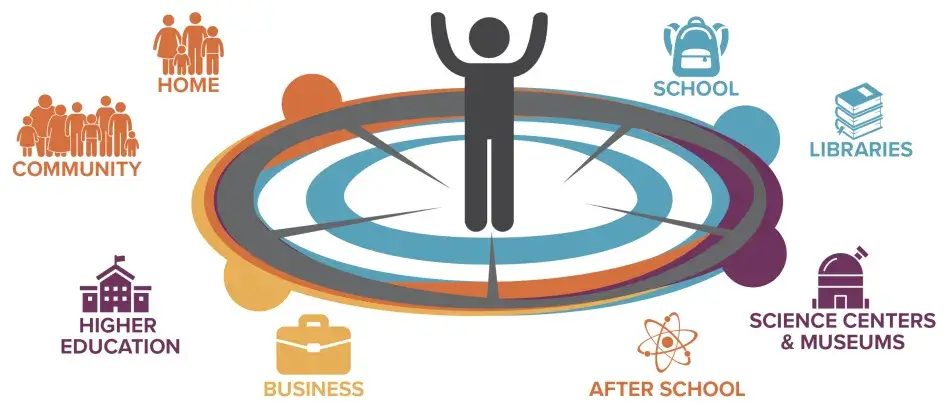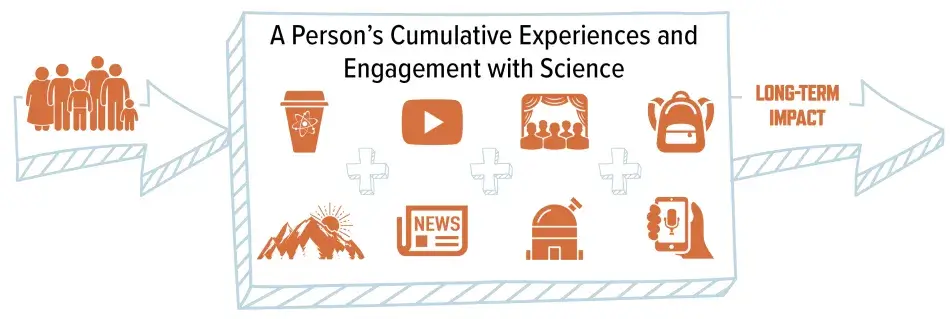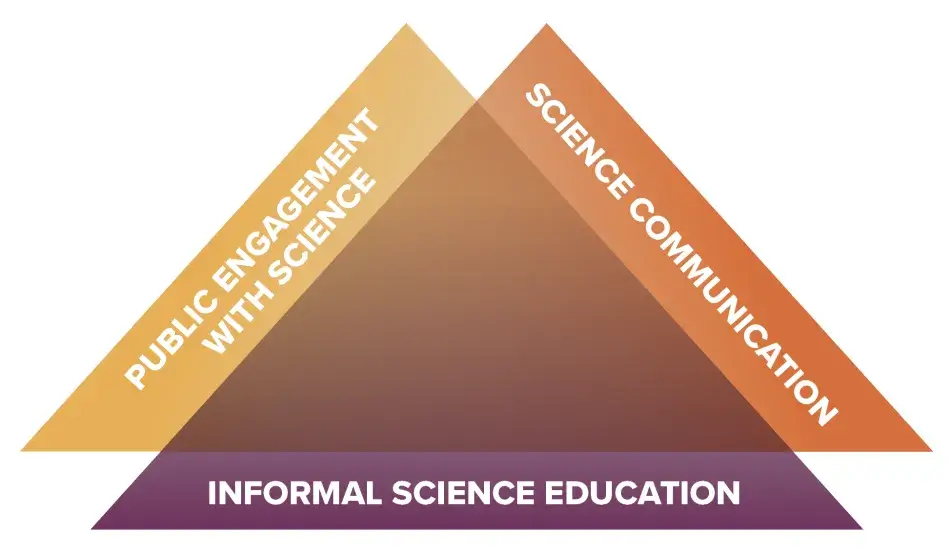Priority 3: Developing Systemic Support for Science Engagement Efforts
As highlighted in Encountering Science in America, there is a diverse and expanding range of opportunities for people to encounter science, including visiting informal science institutions, participating in citizen science activities, or attending science events. These activities can be designed to achieve societal benefits, from broadening participation in STEM to expanding community engagement with research and building trust in information on controversial topics.55 These science-based experiences are the result of efforts in the fields of science communication, public engagement with science, and informal science education. For each of these fields, there are a broad range of institutions and practitioners that contribute to science engagement efforts. A systems-level approach to supporting science engagement reflects the complexity of the landscape by which people come to experience science.
In the context of this priority, providing systemic support for science engagement refers to resource-sharing and bridge-building efforts among institutions or practitioners with shared engagement goals. In addition to improving outcomes of engagement, greater interconnectivity within science engagement landscapes also has the potential to raise awareness of current efforts and increase the number of new activities that build on prior research and experience.
Insights from Encountering Science in America: The Participants
Supporting Institutions
Institutions can provide access to critical resources, from financial and logistical support to the personnel or infrastructure that make science communication and engagement possible. These participants have a significant role in defining the outcomes and potential impact. Supporting institutions include but are not limited to:

Professional Practitioners
Each of the following categories of professionals may possess expertise in science communication, engagement, pedagogy, or, in the case of scientists, a specific subject matter. Moreover, scientists who gain experience and training in science communication and engagement techniques may assume dual roles, becoming facilitators, writers, or producers in addition to content experts. Professional practitioners can include:

GOAL 2: Strengthen local science engagement ecosystems, especially where access may be limited, and increase cooperative science engagement efforts.
The National Science and Technology Council has described STEM ecosystems as being able to “bridge, integrate, and strengthen the learning opportunities offered by organizations across sectors compared with isolated, independent entities.”67 STEM ecosystems, consisting of informal science education, formal science education, universities, industry, government, libraries, festivals, community centers, and other mission-aligned organizations, have traditionally been organized around learning outcomes of science engagement for pre-K–16 students. In addition to these knowledge and skills-based outcomes, local science engagement ecosystems have the potential to address additional outcomes of science communication and engagement associated with lifelong interest, motivation, and behavior change. Moreover, local engagement ecosystems can address community-specific science needs and support programming that accounts for any history of exclusion.

Ongoing Efforts
The STEM Funders Network’s STEM Learning Ecosystems Initiative
The STEM Learning Ecosystems Initiative is a global community of practice with eighty-four communities supporting “cross-sector collaborations to deliver rigorous, effective pre-K–16 instruction in STEM learning.”68 Although individual local ecosystems self-organize, the initiative supports resource-sharing and collaboration between ecosystems. The framework for the STEM Learning Ecosystems community of practice is built around four strategies: 1) cultivating cross-sector partnerships; 2) creating and connecting STEM-rich learning environments; 3) equipping educators; and 4) supporting youth pathways.69
STEM Ecosystems

Source: Figure by STEM Ecosystems, modified with permission.


[Goal 2] Action 1:
Local scientific institutions, schools, science centers, and libraries should (continue to) form strategic partnerships and collaborations on local science issues and engagement outcomes. Local stakeholders (government, university, industry) should invest resources in these ecosystems.
Comprehensive frameworks such as the Science Capital Model developed in the United Kingdom, highlighted in Encountering Science in America, considers the multiple dimensions that can shape the perception that science is “for me.”70 These dimensions include talking about science in everyday life, science literacy, and participation in out-of-school learning. Partnerships between local institutions with shared engagement goals will allow for experiences that “enrich and reinforce” each other in order to build long-term impact.71 These collaborations are particularly of interest for addressing scientific topics that have become controversial in the public discourse.

Case Study
The Potential of Local Efforts to Address Controversial Scientific Topics
As discussed in Perceptions of Science in America, the leaders of the scientific community are among the most-trusted groups compared with bankers, congresspeople, and media representatives. However, there are areas for concern around a minority of specific science topics such as vaccines, climate change, and GMOs. These topics require evidence-based methods, dialogue, and trusted messengers. Local science engagement ecosystems have the potential to engage effectively on these topics. As highlighted in Encountering Science in America, meteorologists have been identified as effective climate change messengers because of their access to sizeable audiences for whom they are trusted sources of information.72 Additionally, informal science educators at zoos, aquariums, museums, and national parks can act as authentic person-to-person messengers when discussing climate change in the context of local impact.73 There are also national networks available to support these types of local efforts, such as the National Network for Ocean and Climate Change Interpretation, which provides informal science centers with training on evidence-based climate change communication approaches.74
GOAL 3: Standardize and increase the number of resources for assessing outcomes and long-term impacts of science communication and engagement.
One takeaway from Encountering Science in America is the need for additional social science research to understand the impacts of science communication and engagement, including on public interest in, understanding of, and support for science. An individual’s underlying attitudes toward science are the product of cultural influences, fundamental belief structures, experiences with science, and prior knowledge about science. The long-term, cumulative impacts of experiences and engagement with science are challenging to assess because these experiences do not occur as isolated events and there is limited data on an individual’s movement between activities. Further, differences in metrics and methodologies limit researchers’ ability to compare existing evaluation data.




[Goal 3] Action 1:
Funders should support professional organizations in establishing shared databases and metrics.
Shared databases and metrics are necessary for comparing engagement activities and assessing long-term impact. Recent investments in shared metrics highlight the potential for this data to be used to identify national trends. Evalfest was founded in 2014 as an NSF-funded community of practice that developed resources for collecting data from science festival stakeholders. To date, Evalfest has created nine methods and worked with twenty-five partner festivals to complete forty thousand attendee surveys. As a result of these efforts, they are able to identify national trends in the audiences for science festivals.75 The funding also supports the development of evaluation scales that are applicable to other science communication and engagement domains.










